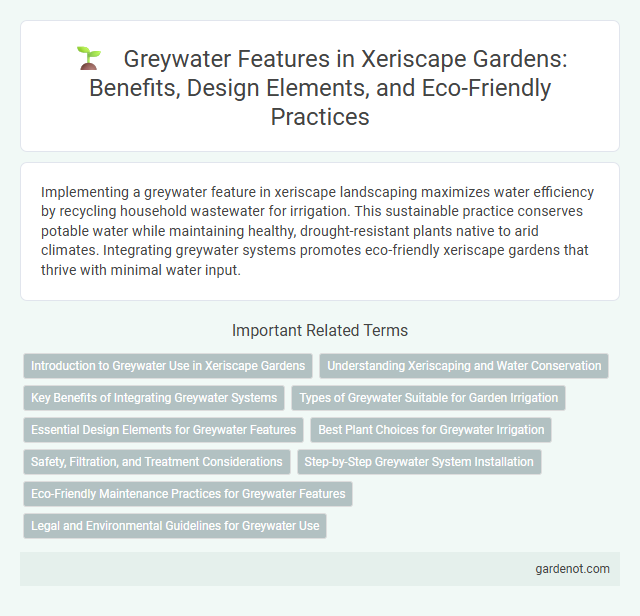Implementing a greywater feature in xeriscape landscaping maximizes water efficiency by recycling household wastewater for irrigation. This sustainable practice conserves potable water while maintaining healthy, drought-resistant plants native to arid climates. Integrating greywater systems promotes eco-friendly xeriscape gardens that thrive with minimal water input.
Introduction to Greywater Use in Xeriscape Gardens
Greywater in xeriscape gardens is reclaimed household wastewater from sinks, showers, and washing machines, repurposed for irrigation. This sustainable practice reduces potable water consumption by directing nutrient-rich greywater to drought-tolerant plants, enhancing soil moisture retention and promoting healthy growth. Proper greywater management minimizes health risks, supports water conservation, and optimizes landscape efficiency in arid environments.
Understanding Xeriscaping and Water Conservation
Greywater systems in xeriscaping reuse water from sinks, showers, and laundry to irrigate drought-tolerant plants, significantly reducing freshwater consumption. Implementing greywater irrigation aligns with water conservation principles by recycling domestic wastewater, minimizing runoff, and enhancing soil moisture retention. This sustainable approach supports xeriscape goals by maintaining landscape health while conserving critical water resources in arid and semi-arid regions.
Key Benefits of Integrating Greywater Systems
Integrating greywater systems in xeriscape landscaping significantly reduces potable water consumption by recycling household wastewater for irrigation, enhancing water efficiency. These systems promote sustainable water management by minimizing runoff and conserving groundwater resources. Using greywater also supports healthier plant growth by providing nutrient-rich water, which benefits drought-tolerant xeriscape plants.
Types of Greywater Suitable for Garden Irrigation
Greywater suitable for garden irrigation primarily includes water from baths, showers, bathroom sinks, and laundry machines, excluding water from toilets and kitchen sinks due to high pathogen and grease content. Light greywater from showers and bathroom sinks typically contains fewer contaminants, making it ideal for subsurface irrigation systems in xeriscaping. Laundry greywater requires careful management to avoid chemicals, but when properly treated, it can efficiently support drought-tolerant landscaping by recycling household water.
Essential Design Elements for Greywater Features
Greywater features in xeriscape design require essential elements such as a dedicated filtration system to prevent clogging and promote safe water reuse. Incorporating slow infiltration zones with plants tolerant to moisture helps in natural filtration and soil absorption. Proper signage and separation from potable water sources ensure safe and efficient greywater utilization in sustainable landscaping.
Best Plant Choices for Greywater Irrigation
Succulents like agave and aloe vera excel in greywater irrigation due to their drought tolerance and minimal water needs. Mediterranean herbs such as lavender and rosemary thrive using greywater, benefiting from its nutrient content without risk of overwatering. Fruit trees like pomegranate and fig adapt well to greywater systems, improving water efficiency while producing abundant yields.
Safety, Filtration, and Treatment Considerations
Greywater systems in xeriscaping require rigorous safety protocols to prevent pathogen exposure and ensure environmental protection. Effective filtration techniques, such as sand or membrane filters, are essential to remove particles and contaminants before irrigation use. Proper treatment, including biological or chemical processes, reduces harmful bacteria and nutrients, promoting safe reuse in drought-tolerant landscaping applications.
Step-by-Step Greywater System Installation
Begin xeriscape greywater system installation by identifying suitable water sources such as bathroom sinks or laundry outlets and securing necessary local permits. Install diverter valves and connect plumbing lines to direct greywater safely into a subsurface irrigation network that targets drought-resistant plants. Regularly monitor system components like filters and pipes to maintain efficient water flow and prevent blockages within the greywater irrigation setup.
Eco-Friendly Maintenance Practices for Greywater Features
Greywater features enhance xeriscape gardens by recycling household water, reducing overall water consumption by up to 50%, and promoting sustainable landscaping. Using natural filtration methods such as mulch basins and native plants with high absorption rates ensures efficient greywater treatment and prevents soil contamination. Eco-friendly maintenance includes regular system inspections, avoiding harmful chemicals, and employing biofilters to support healthy microbial activity and long-term water reuse.
Legal and Environmental Guidelines for Greywater Use
Greywater reuse in xeriscaping must comply with local legal regulations, which often restrict its use to subsurface irrigation to prevent health risks and environmental contamination. Environmental guidelines emphasize treating greywater for pathogens and chemicals before application to protect soil health and prevent groundwater pollution. Proper greywater management supports water conservation efforts while adhering to municipal codes and sustainability standards.
Greywater feature Infographic

 gardenot.com
gardenot.com